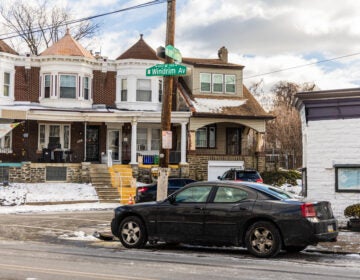Temple’s former Paley Library building is getting a major makeover
The adaptive reuse project is breathing new life into the mid-century brutalist building.

Renovations at the former Paley Library (Temple University)
Have a question about Philly’s neighborhoods or the systems that shape them? PlanPhilly reporters want to hear from you! Ask us a question or send us a story idea you think we should cover.
Temple University is in the midst of overhauling a former library building located at the heart of its North Philadelphia campus.
For more than half a century, Samuel Paley Hall served as the university’s main library. About a year from now, the brutalist building will reopen as the new home of Temple’s College of Public Health, though it will be largely unrecognizable after the $125 million revamp.
“I would venture to say this is probably the most ambitious reuse of structure Temple has ever done,” said William Stelten, a principal with The SLAM Collaborative, the architecture firm leading the project.
The project on Polett Walk merges new and old, like a one-of-a-kind Erector set. Instead of demolishing the old library, the university chose to reuse most of that building’s original concrete structure. The new design redefines the shape of the property by expanding it upward and outward.
“About two thirds of the building stayed and then our building sort of grows out — almost like a flower to the east,” said Stelten.
Paley Hall stood about four and a half stories tall. The structure is now six stories and has none of the precast concrete panels that defined its mid-century aesthetic. The panels were removed and will be replaced by a terra-cotta “skin” as part of a broader effort to make the building more open and inviting, said Stelten.
The bell tower in the front of the former Paley Library will remain, and the new structure will give the appearance of cradling the tower.
The interior will have a completely new look after a series of strategic cuts were made to allow more natural light to spill into the space, moving the property from a fortress of sorts for books to a more human-centric building that gives the College of Public Health a home base for the first time. The college was previously spread across 11 buildings on campus.
“There’s so much you do when you bump into other people, when you have ideas, when you can sit and have lunch together and have a conversation and innovate,” said Jennifer Ibrahim, dean of the College of Public Health.
When it’s completed, students will find a tiered seating area flanked by staircases designed to accentuate the building’s newfound openness. The building will also have state-of-the-art spaces, such as a teaching kitchen and a simulation center. The center will have an area mocked up like hospital and outpatient facilities. It will also have a simulated ambulance bay, as well as replicas of a park, restaurant and rowhome.
“When our students transition out into field work and clinical placements, they’ve already experienced this,” said Ibrahim. “They’ve already thought about all the ‘what ifs’ and the unexpected things that are going to occur, which will make them that much more effective when they go out to serve our communities.”

Subscribe to PlanPhilly
WHYY is your source for fact-based, in-depth journalism and information. As a nonprofit organization, we rely on financial support from readers like you. Please give today.













